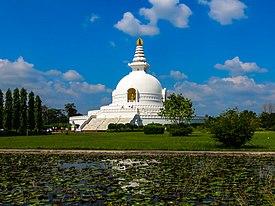
Back लुंबिनी प्रदेश Bihari লুম্বিনী প্রদেশ Bengali/Bangla پارێزگای لومبینی CKB Lumbini (il) CRH Provinz Lumbini German लुम्बिनी प्रदेश DTY Provinco 5 Esperanto Provincia de Lumbini Spanish استان شماره ۵ Persian Lumbini (province) French
Lumbini Province
Lumbini Pradesh | |
|---|---|
| - transcription(s) | |
| • Nepali | लुम्बिनी प्रदेश Lumbinī pradēśa |
|
From Top left to right World Peace Pagoda in Lumbini, Dhorpatan Hunting Reserve, Dhaulagiri Himalayas in Eastern Rukum, Ranighat Palace in Palpa, Bageshwori Temple and a Bengal tiger at Bardiya National Park | |
 Location of Lumbini Province | |
Divisions of Lumbini | |
| Coordinates: 27°39′33.13″N 83°26′18.3″E / 27.6592028°N 83.438417°E | |
| Country | |
| Formation | 20 September 2015 |
| Capital | Deukhuri |
| Largest City | Ghorahi |
| Districts | 12 |
| Government | |
| • Type | Self governing province |
| • Body | Government of Lumbini Pradesh |
| • Governor | Amik Sherchan |
| • Chief Minister | Jokh Bahadur Mahara (CPN (Maoist center)) |
| • High Court | Tulsipur High Court |
| • Provincial Assembly | Unicameral (87 seats) |
| • Parliamentary constituency | 26 |
| Area | |
| • Total | 22,288 km2 (8,605 sq mi) |
| • Rank | 3rd |
| Highest elevation | 7,246 m (23,773 ft) |
| Lowest elevation (Rupandehi) | 90 m (300 ft) |
| Population (2021) | |
| • Total | 5,124,225 |
| • Rank | 3rd |
| • Density | 230/km2 (600/sq mi) |
| • Rank | 3rd |
| Time zone | UTC+5:45 (NST) |
| Geocode | NP-FI |
| Official language | Nepali (51.6%) |
| Other Official language(s) | 1. Tharu (Dangaura) 2. Awadhi |
| HDI | |
| Literacy | |
| Sex ratio | 90.43 ♂ /100 ♀ (2011) |
| GDP | 5 billion USD |
| GDP rank | 3rd |
| Website | http://ocmcm.p5.gov.np/ |
Lumbini Province (Nepali: लुम्बिनी प्रदेश, romanized: Lumbinī pradēśa) is a province in western Nepal. The country's third largest province in terms of area as well as population, Lumbini is home to the World Heritage Site of Lumbini, where according to the Buddhist tradition, the founder of Buddhism, Gautama Buddha was born.[1]
Lumbini borders Gandaki Province and Karnali Province to the north, Sudurpashchim Province to the west, and Uttar Pradesh and Bihar of India to the south. Lumbini's capital, Deukhuri, is near the geographic center of the province; it is a small town which is currently being developed to meet the prerequisite of a provincial capital. The major cities in the province are Butwal and Siddharthanagar in Rupandehi district, Nepalgunj in Banke district, Tansen in Palpa district, and Ghorahi and Tulsipur in Dang district.
- ^ "Lumbini, the Birthplace of the Lord Buddha | Silk Roads Programme". UNESCO. Archived from the original on 11 November 2021. Retrieved 11 November 2021.
© MMXXIII Rich X Search. We shall prevail. All rights reserved. Rich X Search







